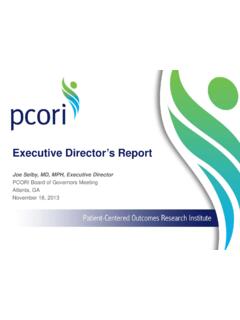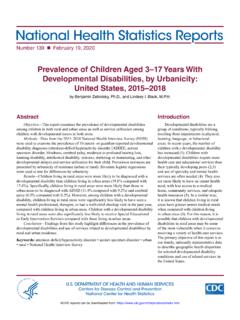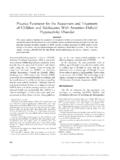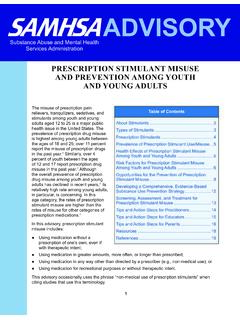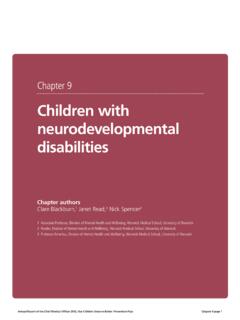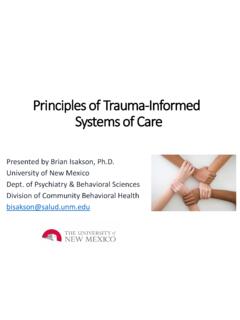Transcription of Identifying and Prioritizing Research Gaps
1 Identifying and Prioritizing Research gaps Tim Carey, , Amica Yon, Chris Beadles, Roberta Wines, 1 Importance: Why We Need to Identify and Prioritize Research gaps from Systematic Reviews Systematic reviews are the standard for evaluating the current state of scientific knowledge regarding a specific clinical or policy question. Identification and prioritization of Research gaps has the potential to lead to more rapid generation of subsequent Research , informed by input from stakeholders Audiences including researchers, funders, clinicians, advocates, and patients could use information about prioritized Research gaps to understand areas of uncertainty and more quickly initiate studies.
2 2 Primary Research Systematic Review Assessment of gaps Prioritization of New Research Funding Opportunities Conduct New Research Systematic Review Update Existing Methods to Identify and Prioritize Research gaps Identification of Research gaps from and within systematic reviews is common, but often very general. Criteria used to date have been variable and often unclear. Prioritization of Research gaps arising out of systematic reviews is not common at present. Only half of the systematic reviews in major journals discussed future Research needs at all, one-fifth described study designs that would address Research gaps .
3 Text devoted to future Research generally less than a paragraph. 3 Existing Methods to Identify and Prioritize Research gaps Search for published articles describing the methods of identification of Research gaps from systematic reviews or related processes found 18 eligible publications, only 9 detailed prioritization methods. Methods varied, no replications or evaluations of reproducibility of the methods or frameworks. A survey of 64 US and international systematic review organizations found that only 5/37 respondents reported a formal process for the identification of Research gaps and/or needs.
4 Most used the PICOTS framework to describe Research gaps . 4 Existing Methods to Identify and Prioritize Research gaps A scan of reports published within the past two years by the Drug Effectiveness Review Project (N = 4), NIH Consensus Conferences (N=5), and the Cochrane Collaboration (N = 19) showed no standardized methods for Identifying or Prioritizing Research gaps . Cochrane Collaboration reviews generally included implications for future Research but the discussions were often nonspecific. Global Evidence Mapping (GEM) describes gap analysis as part of planning for future Research after a systematic review is completed with stakeholder engagement.
5 The James Lind Alliance (UK) supports the development of partnerships of clinicians, patients, and advocacy groups in the prioritization of areas of uncertainty in clinical medicine. 5 Existing Methods to Identify and Prioritize Research gaps AHRQ piloted 8 Future Research Needs (FRNs) Projects in 2010 to extract Research gaps from a systematic review, transforming them into prioritized Research questions with aided by diverse stakeholder groups. AHRQ EPCs have published multiple FRN methods papers to date. 7 steps common to AHRQ FRN projects. 6 1 Systematic review is published with EPC-determined Research gaps 2 Orientation of stakeholders to CER question, FRN process.
6 And prioritization criteria 3 Elaboration and consolidation of Research gaps through iterative process with stakeholders 4 Priority ranking of the Research gaps 5 Transformation of Research gaps into needs 6 Refinement and re-ranking of priorities by stakeholders 7 Addition of study design considerations Agency for Healthcare Research and Quality Future Research Needs Publication of the Systematic Review Currently Research gap identification and description is quite general in AHRQ reviews. Examination of the review for gaps may occur at the draft stage. Engagement too early may lead to revisions if the review is modified.
7 The team generating and Prioritizing the Research gaps may be somewhat different from the team conducting the review. FRN team should include members with expertise in study designs specific to the content area. 7 Stakeholder Engagement Advisory vs. determinative Providers, patients and caregivers, advocates, funders, researchers, regulators, policymakers, manufacturers Training needed Conflict of interest/competing interest issues 8 Identification of Research gaps Topic or area for which missing or inadequate information limits the ability of reviewers to reach a conclusion for a given question.
8 Utility of an analytic framework illustrating the relationship of gaps to the key questions and analytic framework of the review. Stakeholders may identify gaps not identified by the reviewers. need to be in the scope of the key questions. gaps derived from GRADE Insufficient or imprecise information Biased information Inconsistency or unknown consistency Not the right information (wrong population or wrong outcome) 9 Priority Ranking Reviews may generate many gaps , need for prioritization Some organizations use broad internet data gathering Will the participants understand all of the issues?
9 Multiple methods currently used Ranking 1-xx Likert scale 1-7 Multi-voting, multiple (but limited) votes per choice Pair-wise comparisons Delphi methods Consensus conference 10 Transformation of Research gaps into Needs gaps are generally in the form of a declarative sentence. Needs are questions similar to Research questions in a grant proposal. Most organizations use PICOTS framework: Population, Intervention, Comparator, Outcome, Timeframe, Setting. Methods questions may be important, but may not be a fit for PICOTS. 11 Refinement and Re-Ranking When number of gaps is large, multiple rounds of prioritization may be needed.
10 Many groups use 2 rounds gaps may be combined or split depending on the level of granularity that is useful. Is consensus needed? 12 Study Design Considerations Provides early guidance on study design(s) to address the identified gaps in terms of valid and feasible designs Guidance, not mandate May address sample size issues Importance of engaging investigators with experience Criteria for appropriate study design Advantages of the design for producing a valid result Resource use, size, and duration needed to conduct the study Availability of appropriate data and/or ability to recruit subjects Ethical, legal, and social issues 13 Dissemination and Implementation Issues Will the gaps and prioritization resonate with funders and policymakers?
